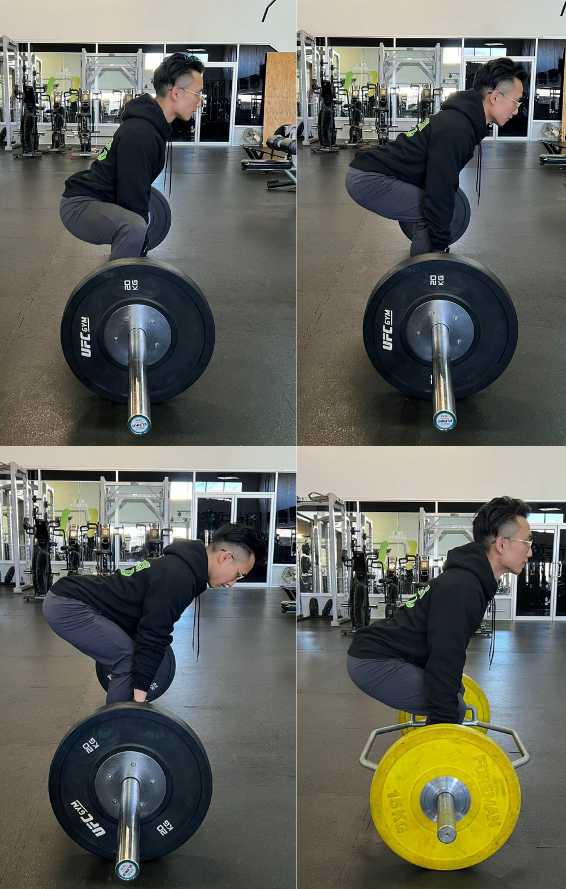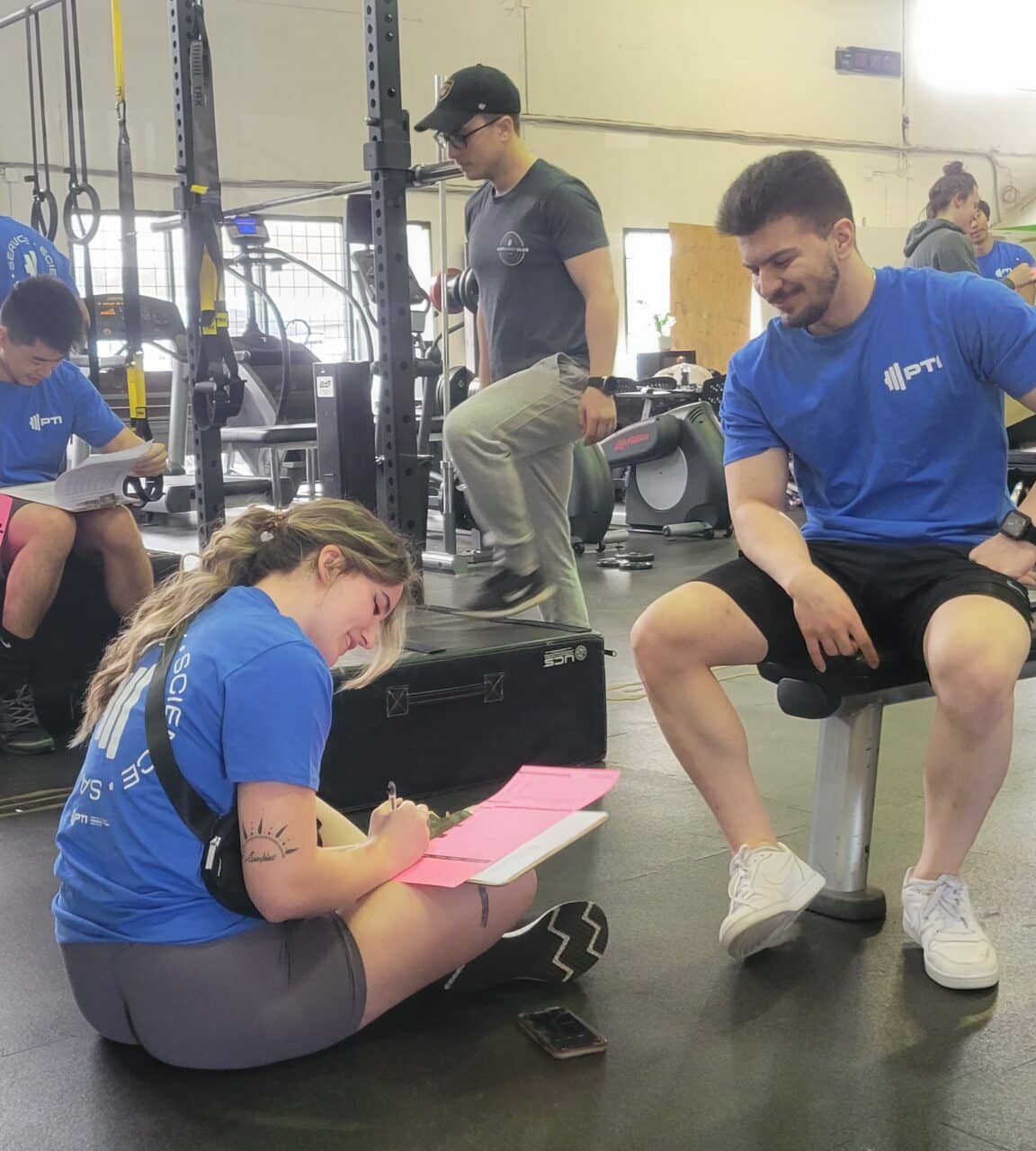August 27, 2021
Squat Variations for New Clients: by Courtney Parson
Our clients know how to sit on a chair. They do it every day. No matter their age, their lifestyle, their occupation, your clients squat. Even if they don’t know that they do, they squat. A squat is not just an exercise, It’s a movement pattern. Usually, what I find is when I ask someone to squat for the first time, they shift their weight into their toes and place a lot of load on their knees instead of hinging through their hips.
Squat Variations Covered in this Article:
- Box Squats
- TRX Squats
- Single Leg Squats
- Get Ups
Box Squat Variations
Box squats are by far the most common squat variations I use with clients. Getting clients to squat down to a box is a proprioceptive reminder to reach their hips back further. You can adjust the height of the box to increase the depth you want them to achieve and get stronger in that range or teach their body what it feels like to achieve a deeper range of motion. You can also use this exercise to teach a client a shorter range of motion. An example of this would be if a client squatted ass to grass and had a pelvic tilt or ‘butt wink’ past a certain point, you could use a box squat to stop them before their pelvis starts to tilt.
There are two versions of this exercise, the first one is where you fully sit on the box, and the second is where you lightly tap your butt to the box but don’t put your weight onto it. I usually start clients with the first variation and then progress them to a traditional squat.
CUES:
- Line up back of calves against the box.
- Engage movement by hinging through hips, reaching hips down and back and touching butt to box or sitting down to box while maintaining a neutral spine, keeping a vertical torso and weight distributed through the middle of your foot.
- Stand up by driving your hips forward, squeezing your butt and simultaneously pressing the floor away from you like you are leg pressing the floor.
- Finish in a standing plank position with shoulders back and down.
I program this exercise in a couple of different ways. Most clients I train will start with this exercise at the beginning of the first phase to teach them, good squat mechanics. I will also use this exercise with senior or elderly clients who have lost a lot of their leg strength to help them learn the squat pattern. This helps me meet my clients where they are.
Some common mistakes with this exercise are shifting weight onto toes when coming up, excessive forward lean or rounding of the back, lack of core engagement (resulting in a back arch), or using hands to get up. I overcome these by asking clients to drive through the middle of their foot or reach their hips back further, teaching clients to engage back muscles and teaching them core engagement.
TRX Squat Variations
A TRX squat is the first squat regression tool I learned as a trainer and has always been part of my arsenal. My favourite ways to use this exercise are for clients with knee pain or hip pain from muscle imbalances or lack of strength in their legs, clients who struggle to keep a vertical torso in a squat, or clients who don’t have the strength to do a box squat without compensation.
CUES
- With TRX straps at mid-length, stand holding onto TRX handles with elbows stacked under shoulder and weight over the midfoot.
- Pulling back on TRX straps to keep the torso upright, brace your core and drive your knees out as you sit hips down and back into a squat like sitting on a chair to around 90 degrees hip flexion, or femur parallel with the ground but everyone’s squat depth is going to differ based on their body.
- The spine should be in neutral, vertical torso, and the knees should be tracking over the midfoot as you squat down.
- Stand up by driving your feet into the ground like you are leg pressing the floor and extending hips forward. Use the straps to assist you up as much as you need to.
I typically will not use this exercise with clients for very long. I use it to teach clients the correct movement pattern, and once they understand the movement and have the strength to do the squat movement without pain, I progress them to a box squat or a goblet squat.
Common compensations I see with this are leaning back and having all of your weight in your hands, like a TRX Row. I cue clients to keep weight over midfoot or ‘nose over toes’ because I use the exercise to strengthen leg muscles and progress them to a squat. This can also show a lack of dorsiflexion as the client is leaning weight back into heels. Other compensations include regular squat compensations like knee tracking and hip tilts.
Are you enjoying this blog post?
Check out our other articles here!
Single Leg Squat Variations

Single leg squats are a progression from a traditional squat and a great way to work on single leg strength when there is an imbalance from one leg to the other (which almost all of us have). My clients usually end up loving this exercise because it is challenging, and they can feel themselves getting stronger at it the more we do it. This is also a great exercise to progress to a pistol squat.
CUES
- Stand against a box about knee height and lift the opposite leg about 30-45 degrees into hip flexion.
- Reach hips back. I like to cue my clients to reach back through their hamstrings and think about lengthening hamstrings as much as you can as you slowly reach your hips back down to the box, keeping the opposite foot elevated. As gently as you can sit weight down onto the box.
- Stand up by driving your leg through the ground and extending your hips forward while keeping the opposite leg elevated the entire time.
The hardest part of the movement for most people is standing up. If a client is struggling with standing up, I will let them use both feet to stand up and focus on the eccentric of lowering down.
Kneeling to Standing Get Up
This is one of my favourite step-up variations; the last part of the Turkish getup. It teaches how to step up using your front leg, and how to get up off the ground safely without using your hands. It is also a very safe, sturdy and a very functional way of loading single leg squat movement.
CUES
- Begin in a full kneeling position with feet in dorsiflexion, glutes squeezed, core braced, shoulders, ribs, and hips stacked.
- Bring one leg forward into a half-kneeling position with a 90-degree knee angle.
- Keeping a vertical torso, drive forward leg into the ground and extend the hips forward into a standing position with back leg placed gently on the floor or driving the knee forward (more stability requirement).
- Reach non-weight-bearing leg back behind you, control movement back into a half-kneeling position with knees stacked over ankles, and bring the forward leg back. (I like to return to full kneeling position every rep as it promotes mobility, blood flow and synovial fluid in the hip joint).
Common compensations I see with this are taking too short of a step back, pressing up off the back leg, or excessively leaning into the front leg. If someone is struggling to step forward with the front leg, I will sometimes ask them to lift the foot of their back leg off the ground, which means they will have to use their front leg. If the client lacks the strength to stand up with total body weight, you can use a TRX Suspension Trainer, bands, wall or a dowel to offset some of the weight.
In Summary
To summarise, there are lots of ways we can change or adjust the squat to meet clients where they are at and use different variations to teach clients to move better and challenge to assist their weak links. Your job as a trainer is to chose the variation they can be successful at and takes them towards their goals.
Tags:
Related Posts
We’re here to help you!
Questions, comments or want to register? Fill out the form below and we will contact you shortly. Thanks!
"*" indicates required fields



